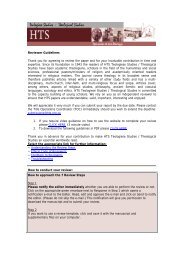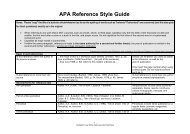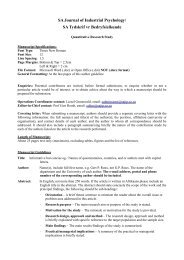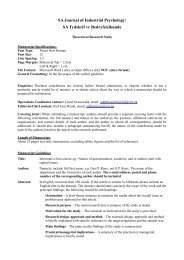Guideline for articles (Qualitative research)
Guideline for articles (Qualitative research)
Guideline for articles (Qualitative research)
You also want an ePaper? Increase the reach of your titles
YUMPU automatically turns print PDFs into web optimized ePapers that Google loves.
Sampling (third-level heading)<br />
The qualitative sampling procedures used in the study, such as cueing, purposive sampling or snow-balling are<br />
described and motivated in this section.<br />
Data collection methods (third-level heading)<br />
In this section the author(s) explain where the data was sourced and which data collection methods (e.g. semistructured<br />
or unstructured interviews, focus-groups) were applied. In some instances solicited documents are<br />
also used.<br />
Recording of data (third-level heading)<br />
The author(s) in this instance explain how the data was accurately recorded, safely stored and managed<br />
without compromising the quality of the data.<br />
Data analyses (third-level heading)<br />
In this case the author(s) explain which methods of data analyses were applied. Different data analyses<br />
techniques result in different variations of qualitative <strong>research</strong>.<br />
Strategies employed to ensure quality data (third-level heading)<br />
This sub-heading is optional here. Author(s) can explain how and why specific techniques are applied to<br />
ensure the integrity of the <strong>research</strong> data and <strong>for</strong> promoting the quality of the study. This can be either<br />
explained under all the sub-headings above or under this separate sub-heading. This is especially important if<br />
the authors are an integral part of the <strong>research</strong> setting.<br />
Reporting (third-level heading)<br />
Author(s) should also explain which reporting style (qualitative writing style) will be followed in reporting the<br />
<strong>research</strong> findings.<br />
FINDINGS (first-level heading)<br />
The next heading is FINDINGS, which appears in capital letters, bold and is centred. This section presents<br />
the results of the investigation in the sequence of the <strong>for</strong>mulated objectives or <strong>for</strong>mulated<br />
postulates/propositions (if applicable).<br />
DISCUSSION (first-level heading)<br />
The next heading is DICUSSION, which appears in capital letters, in bold and centred.<br />
This section normally contains the following eight elements:<br />
•restate the main objective of the study;<br />
•reaffirm the importance of the study by restating its main contributions;<br />
•summarise the results in relation to each stated <strong>research</strong> objective or <strong>research</strong> hypothesis;<br />
•link the findings back to the literature and to the results reported by other <strong>research</strong>ers;<br />
•provide explanations <strong>for</strong> unexpected results;<br />
•provide the conclusion and recommendations (implications <strong>for</strong> practice);<br />
•point out the possible limitations of the study; and<br />
•provide suggestions <strong>for</strong> future <strong>research</strong>.<br />
Second and third-level headings may be used.



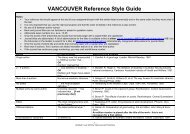
![Reference Style Guide [17-09-2008 Tdv].pdf](https://img.yumpu.com/42195443/1/184x260/reference-style-guide-17-09-2008-tdvpdf.jpg?quality=85)
